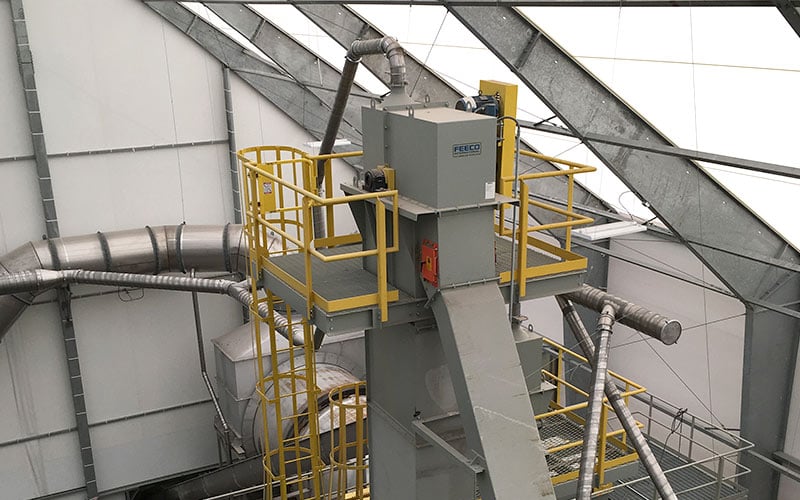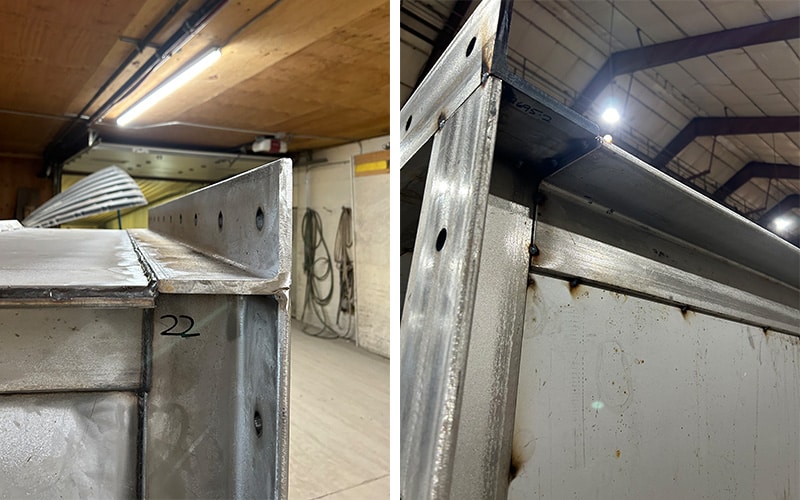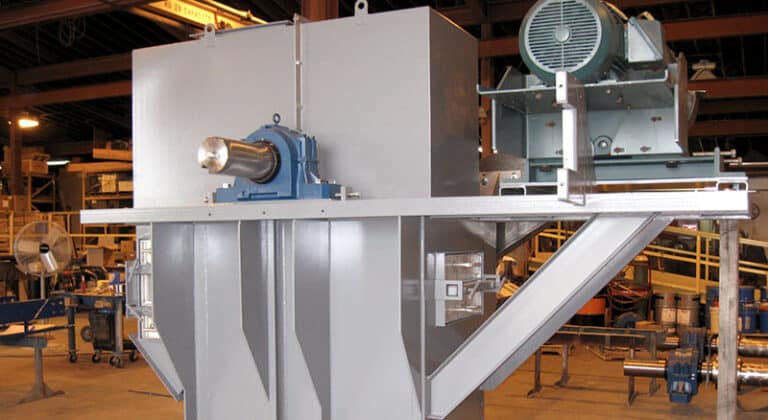Building a quality bucket elevator that lasts requires more than just robust materials and skilled fabrication; it demands a dedication to stringent quality standards at every step of the process. At FEECO International, we understand that quality is the key to achieving lasting, high-performance equipment. This article explores the essential elements that go into a quality bucket elevator, and how rigorous standards ensure reliable, long-term performance.
Consequences of Poor Bucket Elevator Quality
From aggregates to fine chemicals, elevators provide reliable vertical conveying that is critical to moving material around a processing facility. Many elevators are expected to operate 24/7 in harsh conditions and last for decades. In these settings, quality is the foundation of an elevator that:
- Can meet capacity requirements.
- Will run smoothly without interference.
- Is appropriate for the level of duty associated with the application.
- Has a maximum service life when properly maintained.
- Will experience minimal downtime.
Whether through poor design or inferior build, a low-quality bucket elevator can create a host of problems that ultimately increase cost of ownership and chip away at the bottom line. Failure to adhere to key quality standards can lead to:
Increased Maintenance and Repair Costs
A machine that requires constant maintenance and component replacement increases both maintenance and labor costs.
Downtime and Production Losses
Low-quality elevators often require more downtime or may not be able to reach rated capacity, putting production schedules at risk.
Retrofitting and Replacement Needs
Depending on the cause and extent of the issues resulting from poor quality, major retrofitting, frequent part replacement, or even full system overhauls may be required.
Safety Hazards
Poor quality can jeopardize the structural integrity of the unit, creating a safety hazard.
Key Aspects of a Quality Bucket Elevator
Several factors work together to yield a quality solution:
Level of Duty
Buyers must take care in evaluating and securing equipment properly suited for duty to avoid frequent issues and potential early failure.
Not all bucket elevators are created equal; solutions run the gamut from standardized, light-duty models to heavy-duty, custom designs and everything in-between, so it’s important to recognize that quality is sometimes in the eye of the beholder. A bucket elevator may be built to the highest standards for its intended application, but not designed for the level of duty required, resulting in an inferior, seemingly low-quality result. For example, an agricultural elevator may provide long-lasting, superior performance in an ag setting, but employed in a mining setting, would quickly result in problems.
Engineering & Design
Bucket elevator quality starts with engineering and design, which impact every aspect of the equipment’s function, from its structural integrity to its efficiency and safety. Engineers must carefully calculate factors such as bucket design and spacing, drive and motor selection, structural integrity, feeding and discharge configuration, and more. Proper engineering and design ensure the elevator operates as seamlessly and efficiently as possible, without interference.
Additional customizations such as the incorporation of access or inspection doors, service ladders and platforms, and the like can help to extend the accessibility and serviceability of the unit.

FEECO Bucket Elevator with inspection doors (orange), service platform, and ladder with safety cage
Alignment
Precise alignment is a key factor in structural integrity, safety, and smooth operation and is the result of a combined effort between engineering, fabrication, and installation. Elevators must be plumb and square to perform properly long-term.
In addition to proper alignment through design, fabricators must also work to ensure the various components are manufactured exactly to spec and then assembled against tight tolerances. The importance of this is critical considering that mistakes are amplified with added height. For example, if each section of an elevator were 1/16” out of alignment, a 150’ tall elevator would be close to one inch out of alignment at the top. This could result in the equipment being unable to interface properly with the discharge point, which would result in significant interference and tracking issues within the elevator.
Proper installation also plays a pivotal role in securing proper alignment. FEECO recommends the original equipment manufacturer (OEM) and the installation contractor work together to ensure the equipment is installed according to design.
Weld Quality
Welding specifications and weld quality are fundamental to a bucket elevator’s durability, safety, and overall performance. High-quality welding ensures structural integrity and longevity, particularly given the demands of continuous material handling at high loads.
High-quality welds ensure key structural components remain securely connected under operational stress, minimizing the risk of failure from vibration, load stresses, or external impacts.
In this way, consistent, high-quality welding also reduces the likelihood of cracks, fractures, and other failures that may occur in areas exposed to repeated load cycles. Poor welds can quickly lead to degradation, causing cracks to form and spread, which compromises the overall structure.
Accurate welding during fabrication also helps to maintain precise alignment in key components; misalignment due to poor welding can cause issues like chain or belt wear, reduced efficiency in material discharge, and increased vibration—all of which compromise elevator performance and safety.
In applications where materials or environments are abrasive or corrosive, weld quality plays another essential role as well, directly affecting the equipment’s resilience. Welding techniques, such as continuous welds with the proper filler material, help prevent moisture and contaminants from penetrating seams, reducing corrosion risks and extending equipment life.
Ultimately, welding specifications and quality contribute to minimized downtime and maintenance costs, with inferior standards increasing the risk of component failure, posing a safety hazard to plant personnel, and potentially causing costly damage to the elevator and surrounding equipment.
All welding should be backed by a rigorous quality control program that incorporates weld checks.
Materials of Construction
Materials of construction make a significant contribution to an elevator’s overall quality, reliability, and durability. This means not only selecting the proper type of material of construction for the material running through the elevator, but also choosing the appropriate thickness/gauge.
Source material vendors should be thoroughly vetted to verify quality claims and avoid the use of low-cost substitutions.

Heavy-duty angle iron is used to reinforce the casing on this self-supporting bucket elevator
Comprehensive Quality Control
Careful engineering and design, alignment, weld quality, and selection of the proper materials of construction are essential to a quality bucket elevator, but they mean little without the backing of a solid quality control program.
A robust quality control program is essential for ensuring that equipment meets rigorous quality standards, from initial design to final assembly. Systematic quality checks, non-destructive testing procedures, dimensional inspections, and weld integrity validations throughout the manufacturing process are pivotal in detecting potential issues or defects early and correcting them immediately.
A rigorous quality control program also ensures consistency across equipment, giving buyers confidence that the manufacturer can deliver a high-quality system each and every time.
All engineers, designers, fabricators, and assemblers at FEECO follow quality control standards at every stage of equipment design and manufacturing. This includes welding according to ASME certifications and a proprietary weld code, non-destructive testing and weld checks to verify quality, a close collaboration between design and fabrication, and extensive evaluation of material and component suppliers.
Conclusion
A high-quality bucket elevator sets the stage for seamless vertical handling with minimal downtime and maintenance costs. And when it comes to building a bucket elevator that lasts, every detail matters.
With FEECO’s commitment to stringent quality standards, our bucket elevators deliver unmatched reliability, efficiency, and safety. All FEECO elevators are engineered according to the unique material characteristics and process goals at hand and are backed by our comprehensive parts and service program. To discover how our dedication to quality can help you minimize long-term costs, contact us today!

